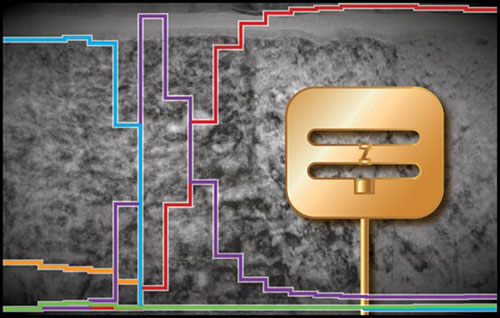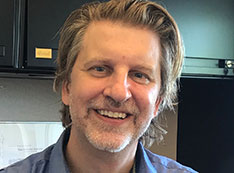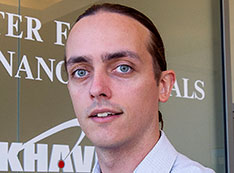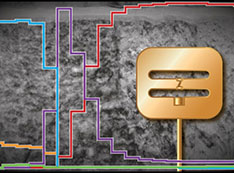Looking Under the Hood of Superconducting Qubits
October 28, 2021
 enlarge
enlarge
(Right) Schematic illustration of a superconducting qubit. (Left) Staircase datasets representing depth profiling of the chemical composition of a niobium qubit. (Background) Transmission electron microscope cross-sectional image of the niobium qubit film.
What is the scientific achievement?
Researchers from Princeton University and staff members from CFN and NSLS-II uncovered microscopic mechanisms limiting the performance of niobium-based superconducting qubits. An integrated investigation of material and device characteristics identified correlations between structural and surface chemistry defects and qubit relaxation times.
Why does this achievement matter?
Practical applications of superconducting qubits—a promising quantum computing platform—are limited by short coherence times. The multidisciplinary approach demonstrated in this study to understand qubit decoherence provides a blueprint for materials-driven improvements of superconducting qubit performance.
What are the details?
Superconducting quantum information bits (qubits) technology is a promising platform for fault-tolerant quantum computation. Significant improvements in qubit coherence have been achieved through novel device designs and improved fabrication processes. However, performance enhancements by these means have started to plateau, indicating that fundamental studies are needed to point out the dominant sources of decoherence. Performing microscopy and spectroscopy experiments at the CFN and NSLS-II, a team of Princeton and Brookhaven scientists investigated niobium thin films deposited by three different methods to understand the relationship between qubit performance and microscopic material properties. At NSLS-II, they determined the oxidation states of niobium through x-ray photoemission spectroscopy with soft x-rays at the In situ and Operando Soft X-ray Spectroscopy beamline and hard x-rays at the Spectroscopy Soft and Tender beamline. At the NSLS-II Soft Inelastic and X-ray Scattering Beamline, they identified spots with missing oxygen atoms through resonant inelastic x-ray scattering. At the CFN, the team visualized film morphology using transmission electron microscopy and atomic force microscopy, and characterized the local chemical makeup near the film surface through electron energy-loss spectroscopy. Their experimental findings revealed correlations between qubit relaxation times and structural and chemical film properties—specifically grain size, suboxide (NbOx, NbO, and NbO2) intergranular penetration, and suboxide intragrain concentration near the surface. This study provides a blueprint for how qubit engineers and materials scientists can collaborate to understand the microscopic mechanisms limiting qubit performance.
CFN Capabilities
CFN Electron Microscopy Facility was used for high-resolution imaging and energy loss spectroscope. XPS measurements were performed at the IOS beamline at NSLS-II, in an instrument operated in partnership between CFN and NSLS-II.
Publication Reference
A. Premkumar, C. Weiland, S. Hwang, B. Jäck, A. P.M. Place, I. Waluyo, A. Hunt, V. Bisogni, J. Pelliciari, A. Barbour, M.S. Miller, P. Russo, F. Camino, K. Kisslinger, X. Tong, M.S. Hybertsen, A.A. Houch, and I. Jarrige, “Microscopic relaxation channels in materials for superconducting qubits,” Communications Materials 2, 72 (2021).
DOI: https://doi.org/10.1038/s43246-021-00174-7
Brookhaven Lab newsroom: “Connecting the Dots Between Material Properties and Qubit Performance”
Nature blog post: “Qubits at the Beamline”
Phys.org article: “Materials for superconducting qubits”
Acknowledgment of Support
This research used the SST-2, IOS, and SIX beamlines of the National Synchrotron Light Source II, and the electron microscopy facilities of the Center for Functional Nanomaterials, U.S. Department of Energy (DOE) Office of Science User Facilities operated for the DOE Office of Science by Brookhaven National Laboratory under Contract No. DE-SC0012704. Qubits were fabricated in the Princeton Institute for the Science and Technology of Materials (PRISM) cleanroom and the Quantum Device Nanofabrication Laboratory at Princeton University. A.P. acknowledges the National Science Foundation Graduate Research Fellowship, B.J. acknowledges the Humboldt Foundation, A.P.M.P. acknowledges the National Defense Science and Engineering Graduate Fellowship, and all Princeton authors acknowledge the Materials Research Science and Engineering Center (MRSEC) Grant No. DMR-1420541 and the Army Research Office Grant No. W911NF-1910016. Certain commercial equipment, instruments, or materials are identified in this paper in order to specify the experimental procedure adequately, and do not represent an endorsement by the National Institute of Standards and Technology.
2021-19372 | INT/EXT | Newsroom











